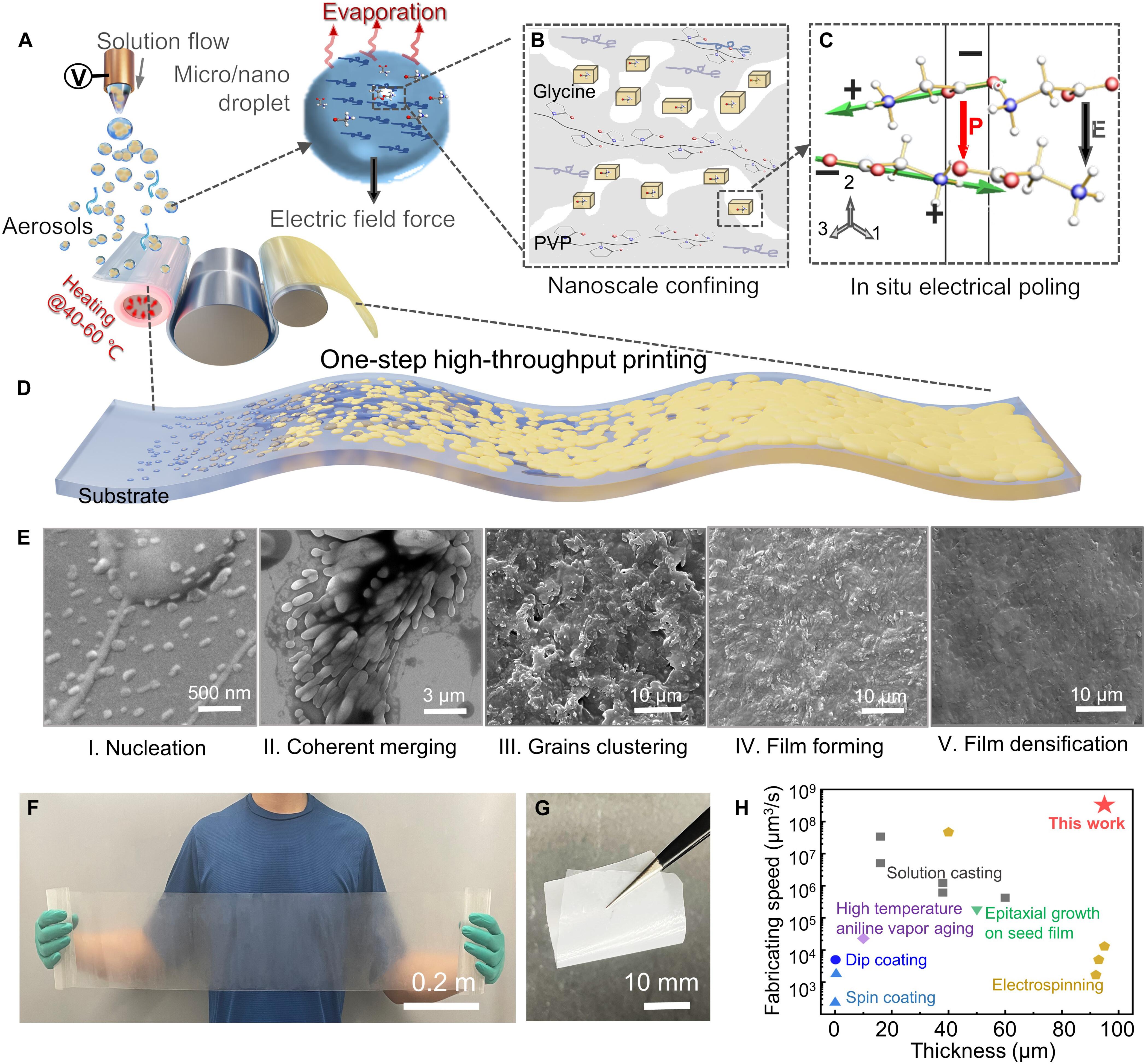One-step high-speed thermal-electric aerosol printing of piezoelectric bio-organic films for wirelessly powering bioelectronics
IF 12.5
1区 综合性期刊
Q1 MULTIDISCIPLINARY SCIENCES
引用次数: 0
Abstract
Piezoelectric biomaterials hold a pivotal role in the progression of bioelectronics and biomedicine, owing to their remarkable electromechanical properties, biocompatibility, and bioresorbability. However, their technological potential is restrained by certain challenges, including precise manipulation of nanobiomolecules, controlling their growth across nano-to-macro hierarchy, and tuning desirable mechanical properties. We report a high-speed thermal-electric driven aerosol (TEA) printing method capable of fabricating piezoelectric biofilms in a singular step. Electrohydrodynamic aerosolizing and in situ electrical poling allow instantaneous tuning of the spatial organization of biomolecular inks. We demonstrate TEA printing of β-glycine/polyvinylpyrrolidone films, and such films exhibit the piezoelectric voltage coefficient of 190 × 10−3 volt-meters per newton, surpassing that of industry-standard lead zirconate titanate by approximately 10-fold. Furthermore, these films demonstrate nearly two orders of magnitude improvement in mechanical flexibility compared to glycine crystals. We also demonstrate the ultrasonic energy harvesters based on the biofilms, providing the possibility of wirelessly powering bioelectronics.

一步式高速热电气溶胶印刷压电生物有机薄膜,为生物电子学提供无线供电
压电生物材料具有显著的机电特性、生物相容性和生物可吸收性,因此在生物电子学和生物医学的发展中具有举足轻重的作用。然而,它们的技术潜力受到某些挑战的制约,包括精确操纵纳米生物分子、控制它们在纳米到宏观层次上的生长以及调整理想的机械性能。我们报告了一种高速热电驱动气溶胶(TEA)打印方法,该方法能够在单一步骤中制造压电生物膜。通过电流体动力气溶胶化和原位电极化,可以瞬间调整生物分子墨水的空间组织。我们展示了β-甘氨酸/聚乙烯吡咯烷酮薄膜的 TEA 印刷,这种薄膜的压电电压系数为 190 × 10 -3 伏-米/牛顿,比行业标准的锆酸钛酸铅高出约 10 倍。此外,与甘氨酸晶体相比,这些薄膜的机械柔韧性提高了近两个数量级。我们还展示了基于生物膜的超声波能量收集器,为生物电子学的无线供电提供了可能。
本文章由计算机程序翻译,如有差异,请以英文原文为准。
求助全文
约1分钟内获得全文
求助全文
来源期刊

Science Advances
综合性期刊-综合性期刊
CiteScore
21.40
自引率
1.50%
发文量
1937
审稿时长
29 weeks
期刊介绍:
Science Advances, an open-access journal by AAAS, publishes impactful research in diverse scientific areas. It aims for fair, fast, and expert peer review, providing freely accessible research to readers. Led by distinguished scientists, the journal supports AAAS's mission by extending Science magazine's capacity to identify and promote significant advances. Evolving digital publishing technologies play a crucial role in advancing AAAS's global mission for science communication and benefitting humankind.
 求助内容:
求助内容: 应助结果提醒方式:
应助结果提醒方式:


